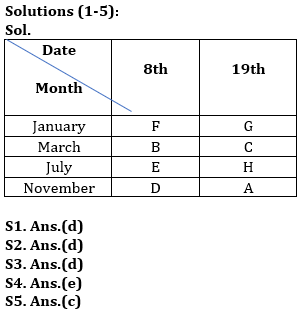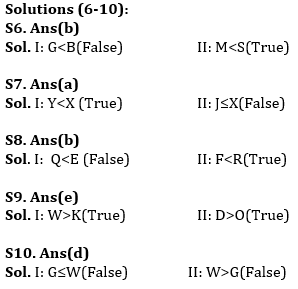Directions (1-5): Study the information and answer the given questions:
Eight employees will have to take the leave in the month of January, March, July and November but not necessarily in the same order. In each month, they all will take a leave on either 8th or 19th of the given months. Not more than two employees will take leave on the same month. Only one employee will take leave on each day.
Only one person will take leave before the G. More than three persons will take leave between G and A. Only one person will take leave between A and H. Two persons will take leave between H and B. Only one person will take leave between B and F. Two persons will take leave between F and C. D will take leave one of the days after E. Neither D nor E will take leave on 19th of the any of the given month.
Q1. Who among the following will take leave on 8th January?
(a) A
(b) C
(c) None of these
(d) F
(e) B
Q2. Who among following will take leave on 8th November?
(a) A
(b) C
(c) None of these
(d) D
(e) B
Q3. H will take leave on which date and month?
(a) 8th March
(b) 19th March
(c) 8th July
(d) 19th July
(e) None of these
Q4. Who among following will take leave on March month?
(a) A, C
(b) F, B
(c) G, H
(d) H, C
(e) B, C
Q5. How many persons will take leave between F and E?
(a) One
(b) None
(c) Three
(d) Two
(e) Four
Directions (6-10): In these questions, relationship between different elements is shown in the statements. The statements are followed by conclusions. Study the conclusions based on the given statements and select the appropriate answer:
(a) If only conclusion I follows
(b) If only conclusion II follows
(c) If either conclusion I or II follows
(d) If neither conclusion I nor II follows
(e) If both conclusions I and II follow
Q6. Statements: W > G = H ≤ B > S = D > N ≥ M
Conclusion I: G < B
II: M < S
Q7. Statements: Y < T = X ≥ B > N = D > H ≥ J
Conclusion I: Y < X
II: J ≤ X
Q8. Statements: Q ≥ C > R = P > F < E > M ≤ O
Conclusion I: Q < E
II: F < R
Q9. Statements: O < Q = V = D > W > G = Y ≥ J > K
Conclusion I: W > K
II: D > O
Q10. Statements: W > P = Z > J < G ≥ I > O ≥ T = Q > S
Conclusion I: G ≤ W
II: W > G
Solutions







 GA Capsule for SBI Clerk Mains 2025, Dow...
GA Capsule for SBI Clerk Mains 2025, Dow...
 The Hindu Review October 2022: Download ...
The Hindu Review October 2022: Download ...
 IIFCL Assistant Manager Result 2025 Out,...
IIFCL Assistant Manager Result 2025 Out,...


